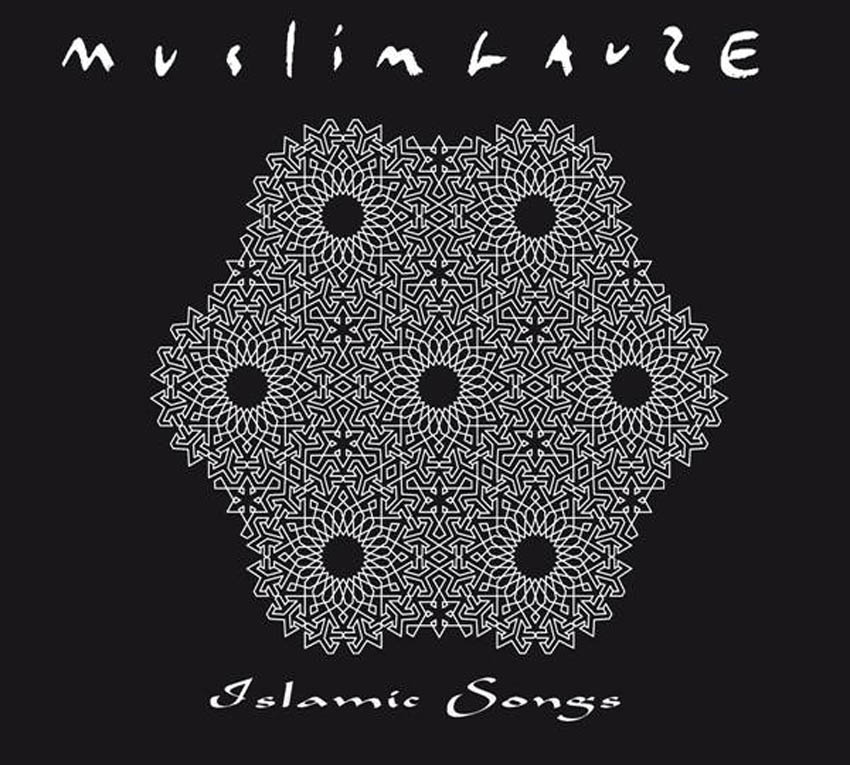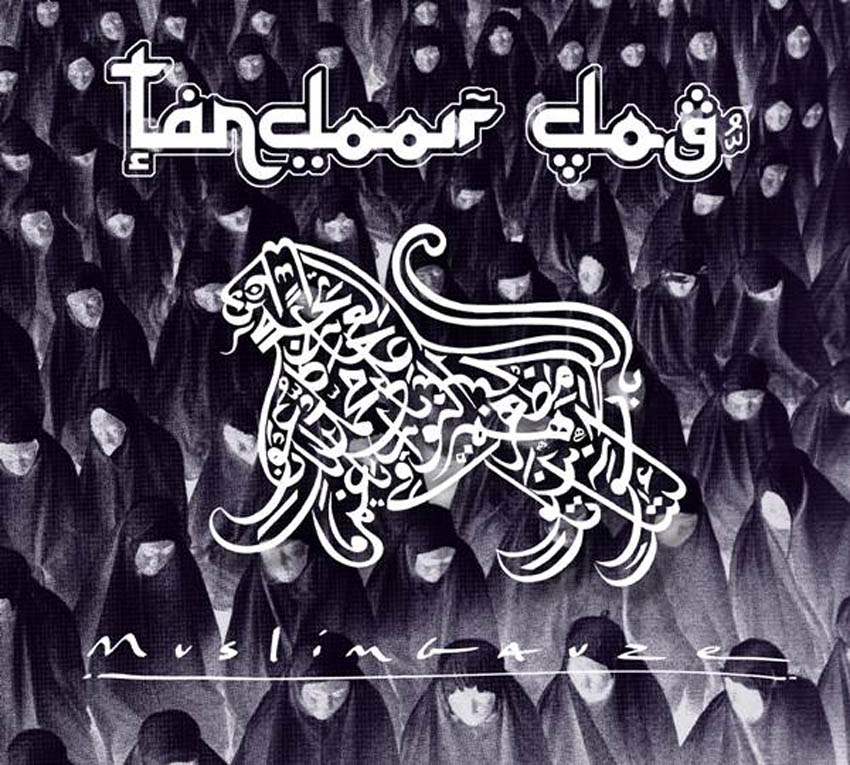 Staalplaat's latest pair of excavations from Muslimgauze's supernaturally bottomless vault is a bit of a surprise, as these two albums contain some of the best material to surface from the departed Bryn Jones in a very long time.  While a good portion of Tandoor Dog has admittedly appeared before, it was only as part of an extremely limited 4LP set that virtually no one has, while Izlamic Songs is an entirely unreleased, fully formed, and coherent album.  To my ears, Izlamic Songs is probably the better of the two (it has higher peaks, at least), but both intermittently capture Jones at the peak of his aberrant and bludgeoningly percussive dub genius.
Staalplaat's latest pair of excavations from Muslimgauze's supernaturally bottomless vault is a bit of a surprise, as these two albums contain some of the best material to surface from the departed Bryn Jones in a very long time.  While a good portion of Tandoor Dog has admittedly appeared before, it was only as part of an extremely limited 4LP set that virtually no one has, while Izlamic Songs is an entirely unreleased, fully formed, and coherent album.  To my ears, Izlamic Songs is probably the better of the two (it has higher peaks, at least), but both intermittently capture Jones at the peak of his aberrant and bludgeoningly percussive dub genius.
Izlamic Songs opens in spectacular, "instant classic" fashion with "I Will Sing Until My Land Is Free," unfolding a vocal  lengthy vocal sample over a very heavy percussion and tambourine loop augmented with ominous buzzing swells and deep bass rumble.  The four other "real" songs left in its wake do not have quite the same bulldozing intensity, lamentably, but the basic building blocks remain the same: I think this album could reasonably characterized as atypically "collage-y" and textural.  It is certainly a very rhythmic release ("Tourist Vice Hole" is built almost entire upon clattering hand drums, for example), yet the emphasis seems to be much more on tweaking vocal and string loops rather than on the groove.  In fact, the sole brazenly groove-y addition seems to be that each song features a simple bass loop that is so deep and overloaded that the actual notes being played are meaningless–the bass exists almost entirely as a forceful physical presence.
Of course, the fact that Izlamic Songs is so sparse on conventional music does not mean that Jones was lazy.  Rather, Jones channeled his formidable energy into the studio, turning his well-chosen loops into vibrant pulsing soundscapes that unpredictably pan, stutter, drop-out, and echo.  Bryn also seems to have been very fixated on reversing samples during this period, as surreal backwards and possibly pitch-shifted loops play dominant roles in a number of pieces.  In fact, it seems like Jones either set out to make an album of hallucinatory psychedelia that somehow derailed along the way or that he succeeded, but did it in a way that is distinctly his own.  I am leaning towards the latter, as the omnipresent clattering clip-clop of the tablas mingled with the mammoth buzzing bass created a heavy and appealing bed that allowed Bryn to be as experimental as wanted in all other respects.  Just in case that was not enough, however, Jones also included a surprisingly effective smattering of hooks throughout the album, the best of which is the twanging string snippet in "Sahara Head Dress" (a motif that also periodically stutters and reverses, in keeping with the surrounding music's obsessive themes).
The first five songs are just the prelude to a more substantial trip down the rabbit hole though: the album's final three songs are remixes of music by Systemwide and Jones drops just about every pretense of striving for song-craft or listenability.  Only the first one is particularly substantial (it is over 8 minutes long), but all are quite nakedly and aggressively experimental.  For most of its duration, "Systemwide Virus Abuse 1" plays like a dystopian future twist on the album's earlier aesthetic: a lazy beat unfolds beneath an all-consuming thick buzzing electro bass pulse that buries everything, yet constantly falls prey to glitch-like cut-outs and manglings.  Then it all abruptly turns into a drum loop accompanied by fluttering electronic chaos, vocal loops chopped into oblivion, and a lot of disorienting echo-abuse.  The remaining two bits of "Virus Abuse" offer up escalating craziness coupled with dramatically shortened running times, at times resembling a recording of an over-caffeinated tabla and candy-colored synth frenzy being eaten by a tape player, while at other times approximating "the sound of a drone crashing" (as Jones topically wrote on the tape almost 20 years ago).
I would not necessarily describe any of the remixes as "great," as they are all either too short or too baffling constructed to succeed as self-contained songs, but such an aggressively deranged ending is somehow exactly what the album needed.  I am not sure if it was Jones' idea or Staalplaat's, but I am a huge fan of the sequencing tactic of closing the album with a plunge into deep experimental waters–it makes for a much more strange and memorable effort and the impact of the coherent songs beforehand is not diluted by a series of very similar regurgitations (a typical Muslimgauze crime).  I have absolutely no idea how this album managed to languish in the vault for so long, given the steady flow of half-baked and redundant material that has already surfaced, but I very happy that it eventually found its way out.  Albums like this are why people are still excited about Muslimgauze.
 

Tandoor Dog, for its part, has a very interesting aesthetic that took me a little longer to warm to, as it is essentially a variation on the "hip-hop" Muslimgauze era (not my favorite time).  Fortunately, it happens to be a fairly weird and unhinged variation, which are traits that are always very much to my liking.  Opener "Aurum Franc Insense Ul Myrrh" sets the album's recurring themes in motion nicely: a laid-back breakbeat groove, an incredibly dense and insistent bassline, stuttering stops and starts, and swarming static-y and mangled samples.  Unlike some of the other extremely beat-driven material that has surfaced, it legitimately sounds like Bryn put some serious work into these pieces long after he had his grooves laid down, as the beats and samples are constantly, vibrantly morphing and changing in texture and dynamic.  Also, Jones' requisite Arab-world samples are atypically snarling and harshly manipulated.
For a while, the sole twist on the formula is that a few songs feature mid-tempo Arabic percussion grooves rather than midtempo breakbeat ones.  Within those narrow stylistic confines, however, Jones found a lot of appealing twists and hooks.  For example, "Under the Burka" sounds like Muslimgauze channeling early Aphex Twin, combining buzzing electro-bass and a queasily dissonant, see-sawing motif that mesmerizingly repeats obsessively.  Also, everything simply sounds great: the clattering drums often have a sharp clarity and Bryn went positively bass crazy, enhancing these songs with a thick, pulsing, neighborhood-rattling physicality.  If there are any Muslimgauze fans out there who just installed totally sick woofers in their Camaro, this is probably exactly what they have been waiting for.
As with Izlamic Songs, things take a sharp detour at the end of the album though, which also happens to be where Tandoor Dog starts to extend beyond the 8 songs originally included in 1997's Tandoori Dog box set.  The first divergence is not particularly promising, as "Damascus" is essentially a cannibalized and extended version of Dar Es Salaam's "El-Dar-El-Beida" that clocks in at a too-long 13:11.  However, the final two pieces ("Noor et Hussein Pt. 1 & Pt. 2") seem take that same raw material and reprise it in a slower, pitch-shifted way that is extremely effective.
Both pieces are relentlessly, punishingly obsessive in their repetition, but also extremely hypnotic.  Also, they are not at all boring (to me, at least), as Jones unpredictably disrupts their insistent throb with violent slashes and stutters of static and crackle.  Both resemble a menacingly inhuman locked groove that is jarringly deteriorating or being ripped apart by a wild animal.  It is entirely possible that I am the only one around that finds that particular aesthetic appealing, but I am thrilled that Staalplaat decided to include such a wildly indulgent and bizarre ending–such a gamble is vastly preferable to any possible alternatives that I can think of.  Also, it makes for a very strong  and focused ending to a surprisingly strong and focused album.
 
Read More

